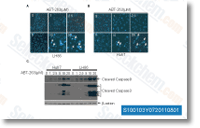smegmatis, straight regulating the expression of more than a hundred genes. GlnR controls important nitrogen anxiety survival processes including primary nitrogen metabolic process pathways, the means to utilise nitrate and urea as substitute nitrogen sources, and the prospective to implement cellular elements to supply a source of ammonium. While we have shown that GlnR plays a central role in nitrogen metabolism in mycobacteria, a few concerns remain unanswered. As an example, the mechanism of activation of GlnR just isn’t identified. GlnR is surely an orphan response regulator along with the corresponding kinase hasn’t however been identified. Investigations can also be in progress to determine the signal indicating cellular nitrogen standing and also the mechanisms by which this signal is detected and trans lated into GlnR activation.
These scientific studies are critical for furthering our knowing of how mycobacteria survive nutrient limiting situations. Approaches Development conditions M. smegmatis mc2 155 wild style and M. smegmatis mc2 155 glnR had been employed within this research. The M. smegmatis glnR mutant Ridaforolimus molecular weight was constructed by recombineering replacing the entire glnR gene with a hygromycin resistance cassette. M. smegmatis was grown aerobically in Middlebrook 7H9 liquid broth at 37 C, 180 rpm. Optimised nitrogen li miting conditions are described. Briefly, an overnight culture of M. smegmatis was washed twice in nitrogen totally free Sautons medium KH2PO4, 0.05% MgSO4, 0. 2% citric acid, 0. 005% ferric citrate, 0. 2% glycerol, 0. 0001% ZnSO4, 0. 015% Tyloxapol and inoculated into Sautons nitrogen zero cost medium, supplemented with 1 mM or 30 mM ammonium sulphate to a beginning OD600 of 0.
08. Growth was monitored by OD600. Ammo nium ions from the culture medium were quantified implementing an AquaQuant Ammonium detection kit. Purification of recombinant GlnR The M. smegmatis glnR and M. tubercu losis glnR genes had been selelck kinase inhibitor PCR amplified from genomic DNA employing particular primers. Digested fragments had been cloned into pET28b to construct tagged protein with His tag in the N terminus and ligations transformed into BL21 pLysS E. coli. Recombinant E. coli strains were cultivated at 37 C in LB broth supplemented with 50 ug ml1 Kanamycin until finally mid log phase, when one mM IPTG was additional and incubation continued at 20 C for 3 hrs. Cells had been harvested, centrifuged and pellet re suspended in lysis buffer, a hundred ug/ml lysozyme, 85. 5 units deoxyribonucle ase I prior to probe sonication.
Soluble protein extract was loaded onto a pre charged nickel column and purified via affinity chromatography using a FPLC AKTA Purifier. Pooled fractions containing His GlnR were dialysed into storage buffer glycerol, 0. 1mM EDTA for antibody production or glycerol for gel shift assays. Protein concentration was established employing the BCA protein assay kit according  to manufac turers instructions.
to manufac turers instructions.
Transcriptase Signal
Telomerases are part of a distinct subgroup of RNA-dependent polymerases.
